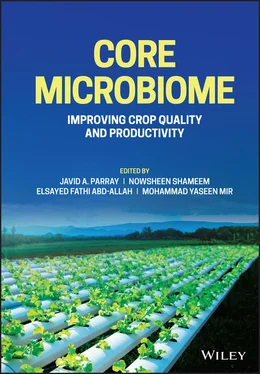Khaloud Mohammed AlarjaniBotany and Microbiology Department, College of Science, King Saud University, Riyadh, Saudi Arabia
Khalid S. AlmaaryBotany and Microbiology Department, College of Science, King Saud University, Riyadh, Saudi Arabia
Khalid F. AlmutaririPlant Production Department, College of Food and Agricultural Sciences, King Saud University, Riyadh, Saudi Arabia
Shahnaz AnjumDepartment of Biomedical Engineering, Sathyabama Institute of Science and Technology deemed to be University, Rajiv Gandhi, Salai, Chennai, Tamil Nadu, India
Himanshu R. BarotSardarkrushinagar Dantiwada Agricultural University, Sardarkrushinagar, Banaskantha, Gujarat, India
Shabir Ahmad BhatCenter of Research for Development, University of Kashmir, Srinagar, Jammu and Kashmir, India
Songul Çanakcι-GulengulDepartment of Biology, Fırat University, Elazıg, Turkey
Kamal ChoudhuryDepartment of Botany, SBMS College, Sualkuchi, Assam, India
Shabeer Ahmad DarCenter of Research for Development, University of Kashmir, Srinagar, Jammu and Kashmir, India
Pranjal Pratim DasDepartment of Biotechnology, Darrang College, Tezpur, Assam, India
Turki M. DawoudBotany and Microbiology Department, College of Science, King Saud University, Riyadh, Saudi Arabia
Rupak DeyDepartment of Earth and Environmental Science, KSKV Kachchh University, Mundra Road, Bhuj, Gujarat, India
Bisma FarooqDepartment of Biomedical Engineering, Sathyabama Institute of Science and Technology deemed to be University, Rajiv Gandhi, Salai, Chennai, Tamil Nadu, India
Madiha FarooqDepartment of Biomedical Engineering, Sathyabama Institute of Science and Technology deemed to be University, Rajiv Gandhi, Salai, Chennai, Tamil Nadu, India
Bahman Fazeli-NasabResearch Department of Agronomy and Plant Breeding, Agricultural Research Institute, University of Zabol, Zabol, Iran
Aparna GunjalDepartment of Microbiology, Dr D.Y. Patil, Arts, Commerce and Science College, Pimpri, Pune, Maharashtra
Abeer HashemBotany and Microbiology Department, College of Science, King Saud University, Riyadh, Saudi Arabia
Mycology and Plant Disease Survey Department, Plant Pathology Research Institute, ARC, Giza, Egypt
Afrozah HassanDepartment of Botany, University of Kashmir, Srinagar, Jammu and Kashmir, India
Nida IdreesToxicology Laboratory, Department of Zoology, Government Raza P.G. College, Rampur, Uttar Pradesh, India
Azra N. KamiliCenter of Research for Development, University of Kashmir, Srinagar, Jammu and Kashmir, India
Fadime KarabulutDepartment of Biology, Fırat University, Elazıg, Turkey
Tulasi KorraDepartment of Mycology and Plant Pathology, Institute of Agricultural Sciences, Banaras Hindu University, Varanasi, India
Aswini KrishnanDivision of Microbiology, ICAR-IARI, New Delhi, India
Ashwani KumarMetagenomics and Secretomics Research Laboratory, Department of Botany, Dr. Harisingh Gour University (A Central University), Sagar, Madhya Pradesh, India
Kailash Chand KumawatDepartment of Soil Science, Punjab Agricultural University, Ludhiana, Punjab, India
Nafiseh MahdinezhadDepartment of Agronomy and Plant Breeding, Faculty of Agricultural, University of Zabol, Zabol, Iran
Manoj Kumar.VDepartment of Mycology and Plant Pathology, Institute of Agricultural Sciences, Banaras Hindu University, Varanasi, India
Dipal B. MiniparaAnand Agricultural University, Anand, Gujarat, India
Mohammad Yaseen MirCenter of Research for Development, University of Kashmir, Srinagar, Jammu and Kashmir, India
Anima NandaDepartment of Biomedical Engineering, Sathyabama Institute of Science and Technology deemed to be University, Rajiv Gandhi, Salai, Chennai, Tamil Nadu, India
Irshad Ahmad NawchooDepartment of Botany, University of Kashmir, Srinagar, Jammu and Kashmir, India
Bijaya Kumar NayakKanchi Mamunivar Government Institute for Post Graduate Studies and Reserach, Department of Botany, Puducherry, India
Asma NazirDepartment of Biomedical Engineering, Sathyabama Institute of Science and Technology deemed to be University, Rajiv Gandhi, Salai, Chennai Tamil Nadu, India
Khushboo PachhigarVeer Narmad South Gujarat University, Surat, Gujarat, India
Javid A. ParrayDepartment of Higher Education, Government Degree College, Eidgah, Srinagar, India
Gulzar Ahmed RatherDepartment of Biomedical Engineering, Sathyabama Institute of Science and Technology deemed to be University, Rajiv Gandhi Salai, Chennai, Tamil Nadu, India
Robeena SarahToxicology Laboratory, Department of Zoology, Government Raza P.G. College, Rampur, Uttar Pradesh, India
Rupak Kumar SarmaDepartment of Botany, Sadiya College, Chapakhowa, Sadiya, Assam, India
Ranjith SellappanDepartment of Agricultural Microbiology, Tamil Nadu Agricultural University, Coimbatore, Tamil Nadu, India
Nosheen ShameemDepartment of Environmental Science, Cluster University Srinagar, Jammu and Kashmir, India
Barkha SharmaDepartment of Microbiology, College of Basic Sciences & Humanities, G. B. Pant University of Agriculture & Technology, Pantnagar, Uttarakhand, India
Sandeep SharmaDepartment of Soil Science, Punjab Agricultural University, Ludhiana, Punjab, India
Seema B. SharmaDepartment of Earth and Environmental Science, KSKV Kachchh University, Mundra Road, Bhuj, Gujarat, India
Sushil K. SharmaICAR-National Bureau of Agriculturally Important Microorganisms, Kushmaur, Maunath Bhanjan, Uttar Pradesh, India
Niraj SinghDepartment of Microbiology, Royal Global University, Guwahati, Assam, India
Baby TabassumToxicology Laboratory, Department of Zoology, Government Raza P.G. College, Rampur, Uttar Pradesh, India
Kalaiselvi ThangavelDepartment of Agricultural Microbiology, Tamil Nadu Agricultural University, Coimbatore, Tamil Nadu, India
Uday Kumar TheraDepartment of Mycology and Plant Pathology, Institute of Agricultural Sciences, Banaras Hindu University, Varanasi, India
Thirunarayanan PDepartment of Mycology and Plant Pathology, Institute of Agricultural Sciences, Banaras Hindu University, Varanasi, India
Shalini TiwariDepartment of Soil Science, Punjab Agricultural University, Ludhiana, Punjab, India
An overabundance of microbial cells is present in every gram of soil, and microbes are found extensively in plant and animal tissues. The mechanisms governed by microorganisms in the regulation of physiological processes of their hosts have been extensively studied in light of recent findings on microbiomes. In plants, the components of these microbiomes may form distinct communities, such as those inhabiting the plant rhizosphere, the endosphere, and the phyllosphere. In each of these niches, the “microbial tissue” is established and responds to specific selective pressures. Although there is no clear picture of the overall role of the plant microbiome, there is substantial evidence that these communities are involved in disease control, enhance nutrient acquisition, and affect stress tolerance. This book first summarizes features of microbial communities that compose the plant microbiome and further presents a series of studies describing the underpinning factors that shape the phylogenetic and functional plant-associated communities. We advocate that understanding the mechanisms by which plants select and interact with their microbiomes may directly affect plant development and health and further lead to the establishment of novel microbes. Despite being one of the simplest metazoans, corals harbor some of the most highly diverse and abundant microbial communities. Differentiating core, symbiotic bacteria from this diverse host-associated consortium is essential for characterizing the functional contributions of bacteria but has not been possible yet. Here, we describe the coral core microbiome and demonstrate clear phylogenetic and functional divisions between the micro-scale, niche habitats within the coral host. In doing so, we discover seven distinct bacterial phylotypes that are universal to the core microbiome of coral species, separated by thousands of kilometers of oceans. The two most abundant phylotypes are co-localized specifically with the corals’ endosymbiotic algae and symbiontcontaining host cells. These bacterial symbioses likely facilitate the success of the dinoflagellate endosymbiosis with corals in diverse environmental regimes. This book primarily focuses on selecting positive and effective interactive core microbiome that are both phenotypically and genotypically very adaptive and sustainable, which further improve crop quality and productivity vis-à-vis sustainable agriculture. The bioengineering concept for rhizosphere improvement has also been discussed in one of the chapters. The book also highlights the structure, characterization, and biotechnological application of aquatic core microbiomes.
Читать дальше











